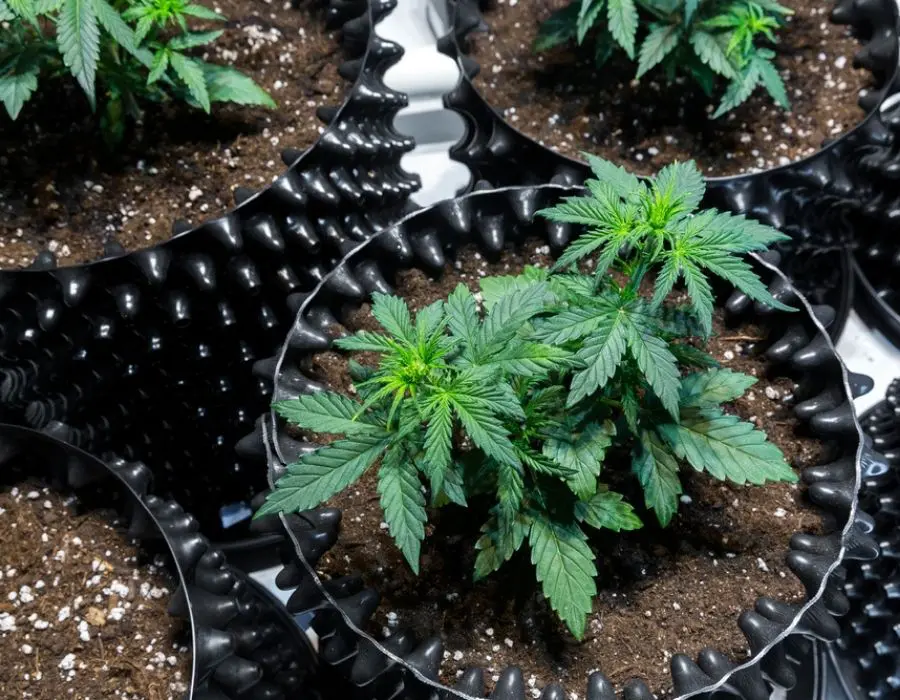Cannabis growers are seemingly always at the forefront of innovations in horticulture, striving to make the necessary tweaks and adjustments to maximize yield, potency, and efficiency. Along with significant technological advancements in lighting, grow environments, and nutrient supplementation, growers in recent years have discovered the advantages of modifying their growing containers as well.
One major advancement came with the development of the Air-Pot, an innovative design that allows ample aeration of a plant’s roots. Turning the traditional pot on its head, so-to-speak, Air Pots, produced by the company of the same name, are sturdy plant pots that look like something from a science fiction movie, covered with dramatic ridges and holes all around the sides of the pot.
Similarly, felt fabric grow pots (frequently referred to by their most common brand name, Smart Pots) have gained favour with cannabis cultivators in recent years for many of the same reasons. Both containers offer a variety of benefits, but each possesses some drawbacks as well.
Why Air Pots for Cannabis?
If you’ve ever transplanted from a typical plastic container, you’ve likely seen what rootbound roots look like: they’ve circled the bottom of the pot and have begun growing into and around one another, creating a dense, inefficient rootball. Because cannabis plants like to grow long, widespread roots to anchor themselves to the ground, one plant can easily fill a pot with a massive root system in no time, particularly during vegetative growth or when grown outdoors.
Air Pots’ design allows significant amounts of air to reach a plant’s roots, effectively curbing the problem of rootbound plants. When roots are exposed to air, they cease growing in a process called “air pruning”, which essentially burns or cauterizes the root, and the energy that would have been spent extending the root further into the growing medium to seek out nutrients is instead spent developing new, healthy roots. Thus, with the introduction of a steady supply of oxygen into a root zone, plants thrive: root growth is sped up, resulting in the development of more fine root hairs, enabling greater nutrient uptake.
Air Pots possess a unique egg-crate-like design with conical ridges all over. The outward-facing ridges contain a small hole, allowing oxygen to air prune roots, while the inverted ridges do not, causing plant roots to fork as they seek out oxygen and nutrients. This ever-increasing forking, which leads to the development of more and more fine root hairs, eventually will consume the entire substrate. This design makes Air Pots suitable for various systems and growing mediums, though some more so than others. Let’s take a look at some of the advantages and drawbacks of working with these futuristic-looking containers.
Benefits of Growing in Air Pots
– Better Root Development – As mentioned, Air Pots will help your plants’ roots to thrive, creating denser, more structured root systems. In fact, plants grown under proper conditions in these containers tend to produce a uniform, spiralized root system unique to the Air-Pot. It’s quite the trademark to boast!
– Greater Nutrient and Oxygen Uptake – Increased amounts of oxygen in your plant’s root zone will allow the plant to utilize more of the goodies you feed to her. Proper nutrition, coupled with increased airflow to the plant’s roots, will cause them to uptake these nutrients and utilize them efficiently for an increased growth rate and more vigorous plant growth.
– Decreased Disease Risk – The increased air circulation in the plant’s roots will help to reduce the risk of diseases such as root rot. Even in a dense, water-retentive growing medium like soil, Air Pots provide enough drainage and aeration to practically eliminate problems associated with overwatering. In lighter, more airy substrates (like coco coir or expanded clay pebbles), the risk is reduced even further.
– Virtually Eliminates Rootbinding – Rootbound plants have sent roots into the farthest reaches of the growing medium to seek out nutrients and water and have run out of space. Air Pots practically eliminate this possibility by continuously air pruning the roots, generating the development of new fibrous roots rather than driving existing roots further into the medium.
